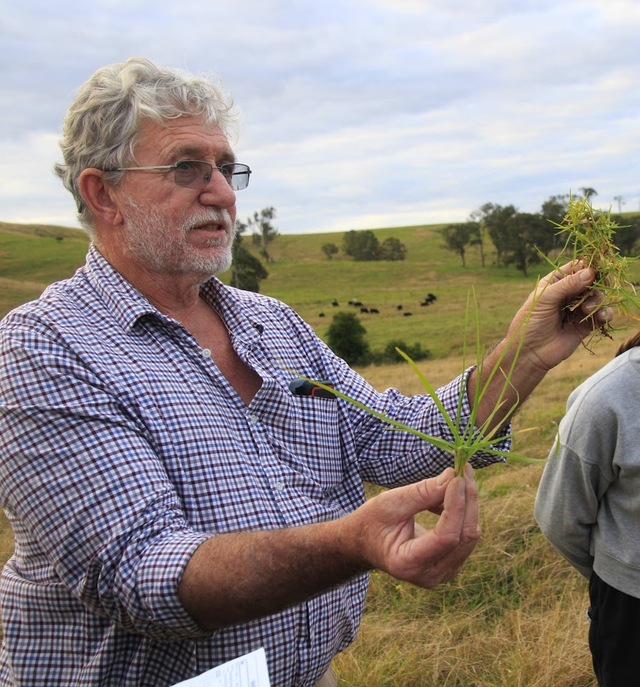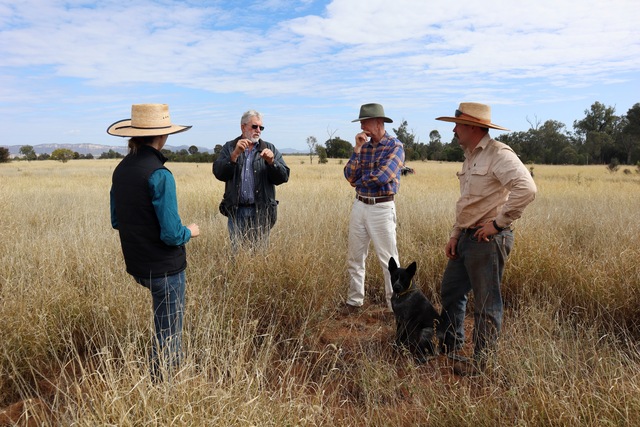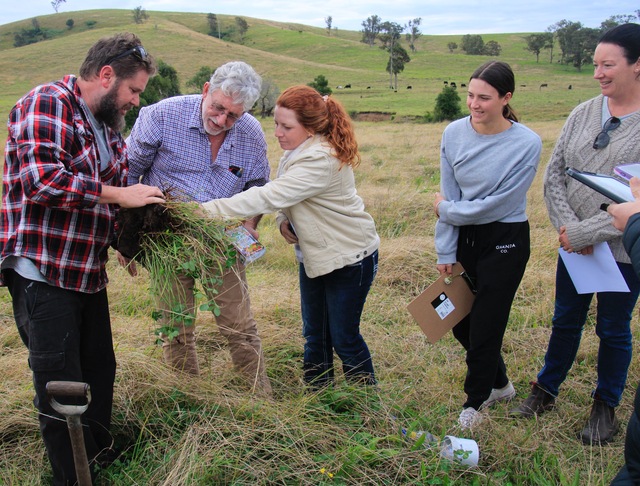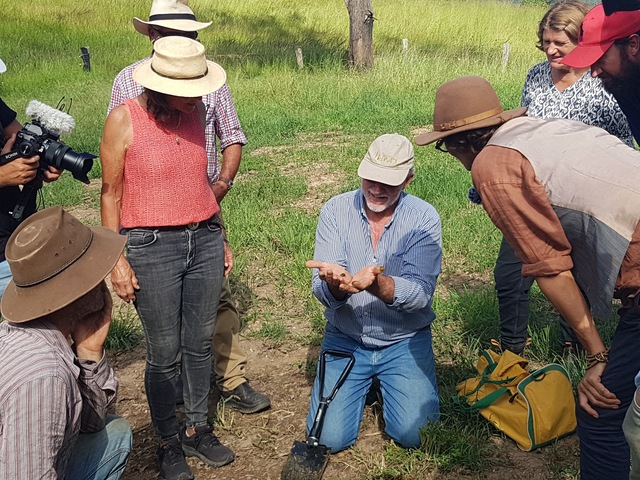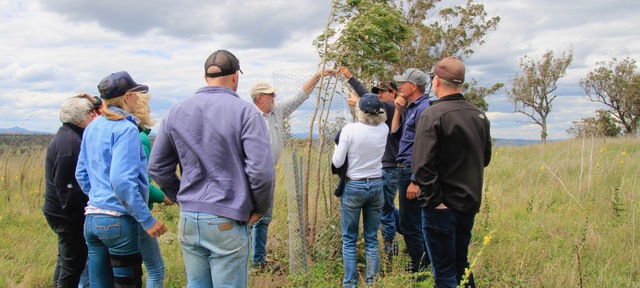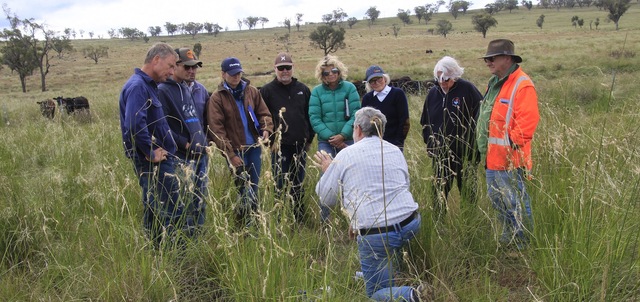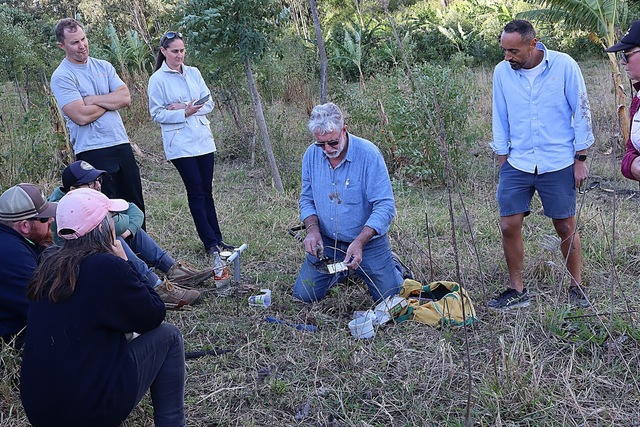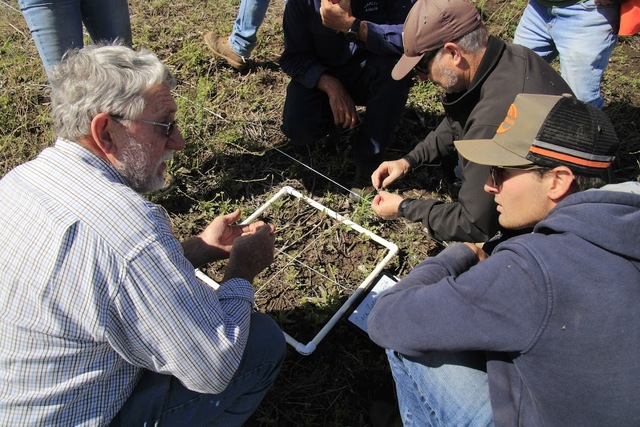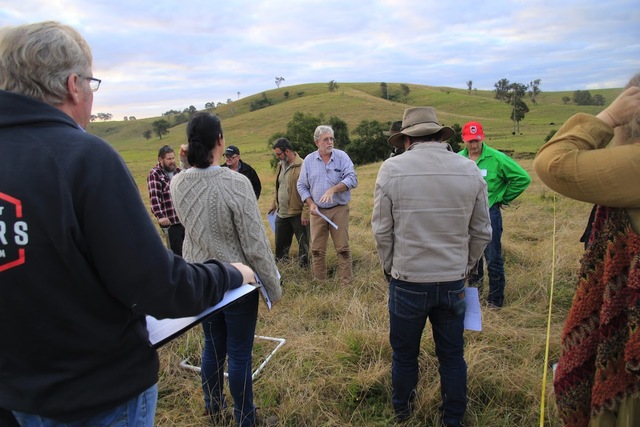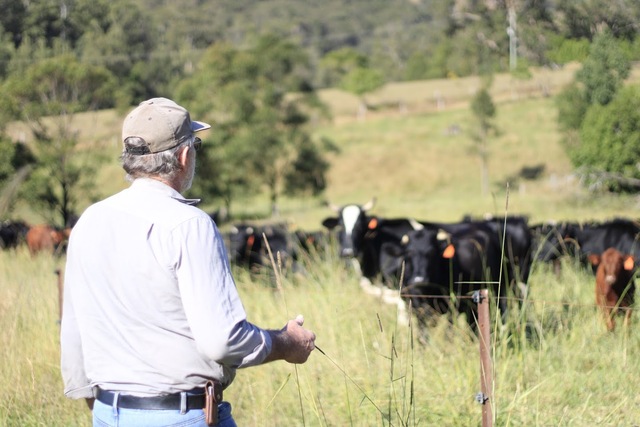The quality of soil and how to improve the biodiversity in the environment are building blocks of life. ERLE LEVEY talks to inspirational holistic management consultant Brian Wehlberg on the steps that can be taken on a regenerative agriculture journey
“There is no other known tool available to humans with which to address desertification that is contributing not only to climate change but also to much of the poverty, emigration, violence, etc. in the seriously affected regions of the world. Only livestock can save us.“
“It’s really what’s inside our head that affects what’s outside in the paddock.’’
From the vast plains of Africa to those of Australia, Brian Wehlberg has been watching nature.
He has seen the great herds of wild animals migrating across the land – the elephant, the zebra, the giraffe, the wildebeest.
It’s been the same in Australia when dinosaurs and giant megafauna roamed the plains at the time of the inland sea.
The grazing animals helped the natural cycle of enriching the soil.
Brian has learnt about the need to immerse yourself completely in life, and understand the way to balance the environment simply by following best farming methods.
Inspired by the teachings of Allan Savory, he uses grazing as a tool to improve the environment. With this comes the resultant increased stocking rates, significant pasture improvement and regeneration of water seeps in farming situations.
Positioned within three United Nations biospheres – Noosa, Cooloola and Sunshine Coast – the focus on regenerative farming in the wider region becomes an essential component of food production.
Work of farmers such as Tim and Amber Scott of K2 Organic Beef at Kandanga, highlight the value of knowledge shared by experts such as Allan Savory and Brian Wehlberg.
Similarly with actress/farmer Rachel Ward and her focus on a holistic approach to the value of regenerative farming to quality of life – these experts inspire and provide direction as well as drive for farmers on their journey, whether regenerative or natural sequence farming.
As director of Inside Outside Management, he and wife Kerry have a complete commitment to the whole of life – integrate all aspects of planning for social, economic, and environmental considerations.
Brian is to lead four holistic management workshops at Kandanga in June, and will be back in the Mary Valley as a guest speaker at the Agvention field days in September.
In a phone interview from his property at Wauchope near Port Macquarie, Brian tells how he started as a farm manager in Zimbabwe.
This comprised his own agricultural enterprise, growing crops for export, breeding cattle and operating a safari business and wildlife conservancy.
He was influenced by the work of fellow Zimbabwean livestock farmer Allan Savory, but also his own observations of nature.
Savory originated a systems thinking approach to managing resources and advocates using bunched and moving livestock in an effort to mimic nature, as a means to heal the environment.
Savory believes only livestock can reverse desertification.
“There is no other known tool available to humans with which to address desertification that is contributing not only to climate change but also to much of the poverty, emigration, violence, etc. in the seriously affected regions of the world.
“Only livestock can save us.“
Grasslands hold the potential to sequester enough atmospheric carbon dioxide to reverse climate change, according to Savory.
Holistic management includes growing food in your own backyard, cooking simple and nutritious meals, and fostering better connections with community and country.
Having grown up in Africa, Brian reflects on the need for rebuilding soil quality even in dry regions such as Namibia with rainfall as low as 19mm a year.
The Mary Valley is close to the coastline so it benefits from rainfall off the ocean and the resultant humidity.
Yet there are times of aridity or even drought-like conditions which makes soil quality and biodiversity important.
“Small organisms such as fungi and bacteria cannot function in a dry environment – everything needs moisture to survive.
“In periods of aridity, it’s essential to have animals with large stomachs that are full of moisture in those dry landscapes. This is to keep bacteria alive, the cycles happening, the breakdown (of plant matter) functioning.
“In a dry environment small organisms are essential to keep things ticking over, and they either dig into the soil and lie dormant or die. The only thing that keeps them alive is the stomachs of large ruminants … large animals.
“Where are the places in the world where temperatures are perfect all year round … Hawaii, Florida?
“The answer is in the stomach of a ruminant animal. It doesn’t matter if it’s a camel in the Sahara or an elk or moose in the Arctic, inside the stomach is just perfect.’’
The problem comes with how farming methods have often either taken them out or changed the behaviour.
As a result it’s hard to maintain the quality of soils, whether for grazing, growing apples or lettuce.
Most of the biodiversity is above the soil, yet we have used slash and burn for centuries and often the soil, especially in Australia, the biology can be poor.
“If you want to get a functioning soil, it’s essential to increase biodiversity.
“We can see country with not a tree in site.
“We have taken the tree as a standard for biodiversity but have completely disregarded what is under and around it.
“The tree has become the epitomy of biodiversity.
“What is desperately needed is carbon in the soil. That is an important tool to increase biodiversity.
“When trees die in arid environments they stay there, they don’t break down. They may have been ring-barked more than 100 years ago and they still stand there in paddocks. It really slows down the circle of life.’’
Savory’s wisdom came from watching whole herds of native animals wandering across the plains of Africa.
“It’s a really important tool to build biodiversity,’’ Brian said.
“Here in Australia, the most dense concentration of fossilised footprints is at Winton.
“Australia had a huge population of ruminant animals. They would have performed exactly the same role as those in Africa in recycling nutrients.
“The water cycle and mineral cycle, the energy flow is the same no matter where you are on the planet.’’
The wildlife was always a passion but once holistic thinking kicked in he realised how much area chemical crops such as tobacco consumed.
He started building biodiversity into the soil and used mainly livestock for fertility, as well as chickens.
The upheaval of Rhodesia becoming an independent Zimbabwe helped in Brian’s decision to live in Australia, first at a property near Injune before settling on Port Macquarie.
He points out that some Mary Valley farmers have adopted chickens as spreaders of fertiliser.
“Chickens are absolutely magic.
“I use a pressure gauge to test the resistance of soil. The penetrometer measures the denseness, compaction, consistency or penetrability of a wide variety of soil.’’
Like using keys or a pen to test the wicket at a game of cricket, using the penetrometer at the front of the chicken caravans can be hard work.
Yet testing after the caravan has moved across the soil, the operator will almost fall on their face as the soil has changed so much in just a couple of days.
“Like anything, we can use chickens to destroy the environment if we keep them in one place too too long.
“The minute we are trying to mimic nature and in more dense flocks, only spend a day or two on a patch of ground, it reverses the process.
“Livestock – whether chickens, guinea pigs or cattle – are a tool.
“Like a hammer, you can build houses or knock them down with them. It’s the same with animals … we can build environments or destroy them.
“It’s how we manage those things. They are part of the improvement of the environment.
“We can see improvements very quickly.’’
The shift in thinking about carbon in soil has been an interesting turn of events, Brian said.
“At a conference in Albury recently you literally couldn’t turn around without bumping into a carbon person.
“They have been focussed on technology but the big shift seems to be into biodiversity credits.
“Ultimately that’s what we want.
“Coal is carbon but you are not going to feed people on it. It does not keep your soils healthy.
“We want that carbon stored … it is the building block of all life.’’
If we were to remove all the plants from a square metre and measure the carbon levels, then measure them again five minutes later, the level would be the same.
“The fact the land is now bare, you know the carbon levels will have dropped in five weeks, five months, five years, 10 years or 50 years.
“You have stopped all life.
“As far as being managers of the land – I would like to know if what I did yesterday was moving us towards more biodiversity and resilience – more carbon capture.
“There are new technologies coming but a lot can happen in five years and as land managers we need to be more proactive …. we need to be looking at soil surface, keeping the surface covered and plant species improving.
“You know your carbons will be improving, you will be carrying more stock, apples, pears … it’s all bundled together.
“We can improve it or destroy it. Everything is connected.
“Nature is pretty forgiving, even though we’ve been hammering it for a couple of hundred years.
“That’s good news …. we need to adjust and live with acts of nature.
“If we are creating the problems every day, whether it be a farm or a vegie patch, then we can undo it – quickly and easily.
“We are at an exciting point. You cannot pick up a newspaper or a magazine without there being something about regenerative farming.
“That tipping point of 15-18 percent of agreeing on the way to do things is fast approaching.
“That’s when the majority comes on board. We are hurtling towards that.’’
Watching farmers markets is a good indicator of the acceptance of regenerating agriculture, Brian said, and if we are to develop new ways of doing things it will regenerate environments.
“The leaps and bounds that have been made in past five years, 10 years … with pasture crops and cover crops. It’s outstanding.
“The explosion of farmers markets in the past 15 years tells me there is demand.
“A lot of farmers are connecting directly with consumers.
“There will be new technologies, methodologies – new ways of doing things that will regenerate the environment.
“The knowledge is out there. The biggest blockage to change is our current knowledge … even when we know it is not going anywhere.’’
Huge opportunities for different farming methods came from Covid, Brian said.
People who have moved from town to regional areas have focused on quality of life but also an holistic quality of life.
“It’s not just about working harder and earning more money, it’s that connection with a good, healthy environment. It’s about being healthy. It’s all of those things.
The idea that land is regarded as a resource to simply make money from needs to be turned around. Long-term health of the land needs to be factored in.
Using the example of trees, Brian said they need insect populations to maintain them.
“When a tree sheds a leaf, it decides to. It takes the goodness out and chucks it on the ground.
“The leaf is organic matter yet nutrition-wise you could not feed anything with it.
“With grass, when it dries it keeps animals alive.
“They are different processes.
“Here at Wauchope, when the bushfires came through, we would be raking litter to create a firebreak. That’s when we realised what we were raking was oxidised leaf and the soil was rock hard.
“Why are soils not functioning? I can only put it down to the fact the insect populations everywhere have declined dramatically.
“There are no insects so there is no breakdown of leaf matter.’’
The turning point to holistic farming for Brian was understanding the need to build resilience, whether for wildlife, for grazing animals or soil.
If there is a bad year from drought, fire or flood the animals die.
“When season breaks – as it always does – there is not the chance to rebuild stocks of giraffes, cheetahs or leopards. There are no sale yards for that.
“Building that resilience – that became a driver.
“Until governments start creating a vision, one that isn’t focussed on a problem, we will be dealing with avoiding or overcoming issues.
“If you are going to start moving to a better quality of life, healthy environments, clean running water, covered creek banks – it will take time. Paint a picture of making decisions towards that rather than compounding a problem.
“When you focus on problems you get more problems.’’
Coming to Australia in his 40s has taught Brian many skills – from fixing a tractor to soldering a toaster.
“Least of all was horse riding. But we survived.
“Our best friends are up in Arcadia Valley. Some of them third generation, which shows they have been successful and productive.
“That’s been really exciting.
“We spent eight years there and have ended up in New South Wales in completely a different environment.
“We formed a partnership to run pigs, cattle and chickens … that was on 622 acres of which 80 acres was rainforest.
“Having grown up in hot dry central Africa and then hot, dry and central Queensland, to walking through rainforest, picking wild mandarins and passionfruit.
“Then discover ticks, copper deficiencies and realise every environment has deficiencies.
“We have got to make them work, no matter where we are on the planet.’’
One of the biggest lessons learned, when talking rural farming, has been the importance of neighbours.
“They are your best asset. We can work so hard you don’t have time to scratch yourself, so how do you continue to develop really strong relationships with neighbours?
“It’s critically important to surviving and having a really good rural life.
“Getting people to acknowledge that and plan for it.
“Look at the bushfires, and every day there would be people popping in. It’s so important.
“You have to keep working at it. You need a clear vision of what it should look like. The barbed wire fence is not your boundary.’’
As a holistic management consultant, Brian moves around Australia presenting workshops.
“Observation changes minds,’’ he said. “Not arguments.’’
Can you separate the land from people and from finances?
“I don’t believe you can. Healthy land, healthy people, healthy finances … you cannot separate them.
“The only true way to support this country is a healthy environment.’’
HOLISTIC MANAGEMENT: A FOUNDATION FOR REGENERATION
Kandanga/Mary Valley
Eight-day full Holistic Management Course (four two-day sessions)
Session 1: June 11-12 (Tuesday – Wednesday); Session 2: July 9-10 (Tuesday – Wednesday); Session 3: Aug 6-7 (Tuesday – Wednesday); Session 4: Sep 3-4 (Tuesday – Wednesday).

